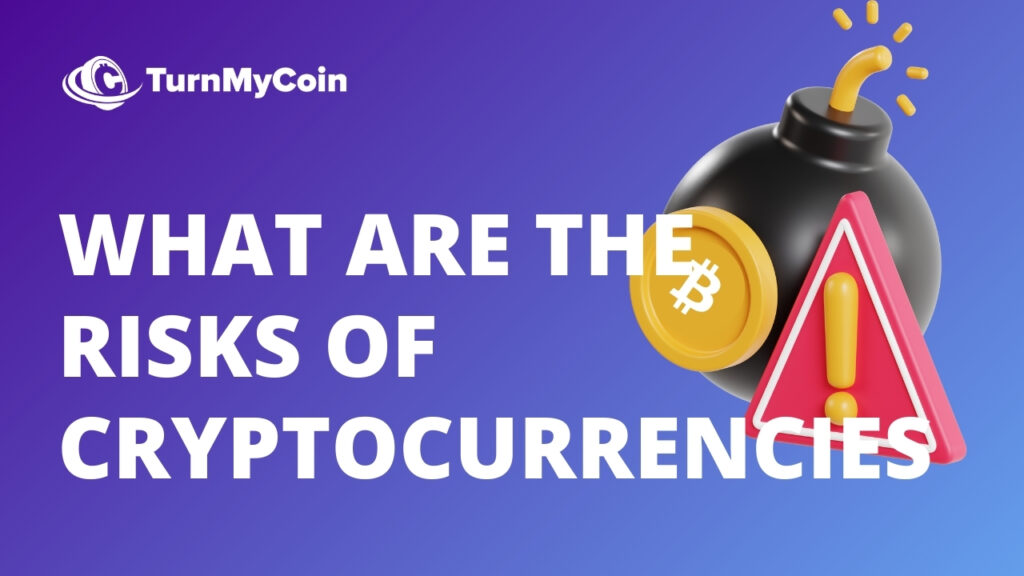Last updated on April 24th, 2024 at 07:19 am
Introduction
Cryptocurrencies are a kind of virtual or digital currencies which use cryptographic techniques to safeguard economic transactions and regulate the development of new units.
Introduced with Bitcoin in 2009, these decentralized assets have brought about a monetary revolution, challenging established banking methods and also introducing disruptive technologies like blockchain.
The explosion of new altcoins like Ethereum, Solana, Binance Coin, ICOs along with decentralized finance (DeFi) platforms makes the crypto space an increasingly volatile and complicated market.
This article explores the multifaceted risks of cryptocurrency trading and investing, offering insights into effective risk management strategies to navigate this dynamic landscape.
Table of Contents
Risks of Cryptocurrency Trading & Investing.
The crypto markets are notoriously volatile and offer possible financial gains alongside potential serious losses for participants. Effectively navigating these risks calls for a multifaceted approach which includes major mitigation strategies for possible downsides.
A strategic and proactive approach which includes:
- Research,
- Security measures,
- Volatility comprehension,
- Diversification,
- Constant information assimilation and
- Platform choice
helps navigate the crypto landscape and also maximizes financial success.
1. Market Volatility
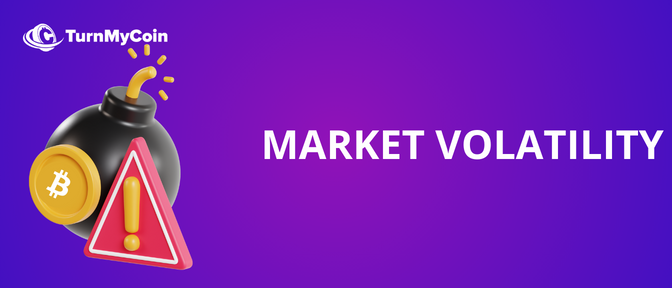
The reason for cryptocurrencies ‘unique price volatility is they’re well-known and like traditional assets. Individuals searching for long or short-term investing options should know the cryptocurrency volatility. The capricious nature of price fluctuations demands sophisticated risk management.
Unlike traditional assets, cryptocurrencies lack the stability that more established financial instruments generally enjoy. This lack of predictability forces investors to adopt a nuanced and agile perspective when navigating the turbulent cryptocurrency industry.
Rather than concentrating on fixed or predefined strategies, investors should be flexible enough to react to shifting market dynamics. Understanding market volatility is more than a suggestion. It’s a mandatory prerequisite for anybody buying crypto.
Failure to recognize the unpredictability of cryptocurrency prices could place investors at higher risk and financial pitfalls. Consequently, an awareness of market volatility is a vital factor in designing robust investment plans.
No one-size-fits-all mentality should be adopted when approaching the cryptocurrency market. Rigidity in strategy might be counterproductive when confronted with the volatile price movements characteristic of cryptocurrencies. Rather, a responsive and pragmatic mindset is necessary to manage risks linked to market volatility.
In a nutshell, navigating the cryptocurrency landscape calls for more than a brief acknowledgement of its price volatility. It requires an adaptive and strategic mindset considering the dynamic character of the market. Investors who understand market volatility will be better placed to make educated choices, hedge risks and likely cash in on the cryptocurrency ecosystem’s special possibilities.
2. Regulatory Uncertainty
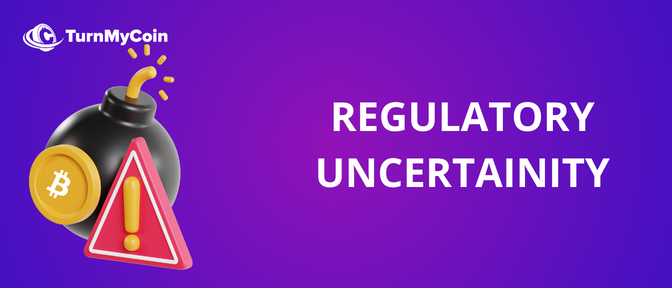
Another risk of cryptocurrency investing is Regulatory uncertainty. There are substantial regulatory distinctions among cryptocurrencies globally that may cause uncertainty for both investors and traders. Varied jurisdictions have taken various approaches, creating a confusing regulatory landscape. All this variation in regulatory frameworks requires constant vigilance and flexibility from market participants.
The ripple effect of regulatory decisions impacts the whole cryptocurrency market. Participants must be educated about regulatory changes and ready to adjust to changing environments. The dynamic nature of cryptocurrency regulations requires an informed and active position from those on the market.
The regulatory uncertainty comes from the absence of a worldwide consistent framework for cryptocurrencies. With distinct paths taking place, traders and investors face challenges in understanding and navigating the regulatory landscape. This disparity mainly prevents market participants from predicting how regulatory decisions in one jurisdiction impact others globally.
Here adaptability is vital. Market participants must be informed about regulatory developments in their countries and anticipate the effects of decisions taken everywhere else in the world. This particular adaptability isn’t an automatic one. It’s a requirement in a marketplace where regulatory uncertainty is constant.
The regulatory landscape calls for nuanced understanding due to the market sensitivity to regulatory changes. Traders and investors should be informed and follow regulatory developments.
Where possible, proactive engagement with regulators might also encourage a far more stable and predictable regulatory environment.
3. Security Concerns
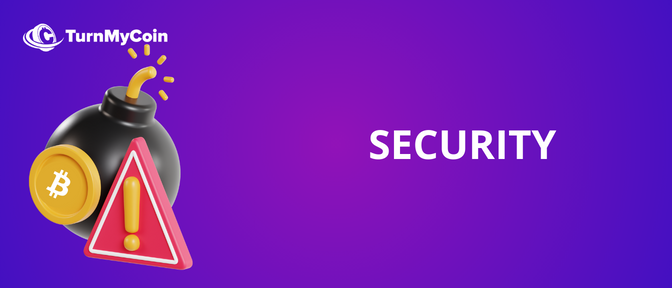
Cryptocurrencies possess an electronic nature and thus are prone to hacking and cybersecurity attacks and need a comprehensive approach to digital asset security. Here conventional security measures fail and need a holistic approach from wallets to exchanges and best practices. The cyber-prone nature of digital assets calls for the adoption of robust security protocols.
The simple fact that cryptocurrencies are electronic permits them to be susceptible to unwanted access by unauthorized individuals. Consequently, digital asset protection is a vital concern in cybersecurity.
Addressing this challenge calls for a lot more than merely conventional security measures; It demands a holistic strategy which considers all facets of the cryptocurrency ecosystem.
Wallets are digital retailers for users’ cryptographic keys and therefore are particularly popular targets of attack. They’re adding advanced encryption and multi-factor authentication as part of a general protection framework.
Likewise, cryptocurrency exchanges – as places for transactions and trading – have to strengthen their defences against this kind of breach. This includes installing advanced intrusion detection systems and providing constant surveillance to detect and thwart new threats promptly.
Following best practices becomes a cornerstone of the holistic security approach. This includes software upgrades, security inspections and user training on possible dangers, preventive measures and using Hardware wallets like:
- Trezor,
- Ledger,
- Ellipal Titan,
- Keepkey.
Inculcating a culture of security consciousness amongst stakeholders in the cryptocurrency ecosystem helps improve the defences against cyber threats.
4. Lack of Investor Protection
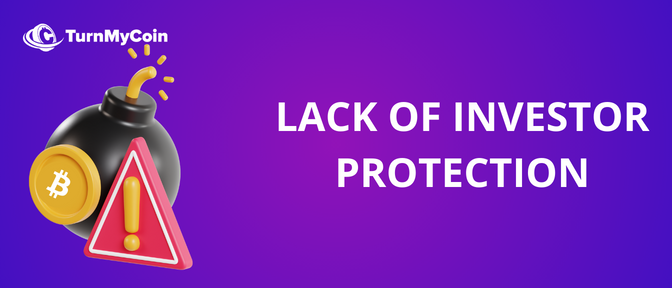
There are no investor Protections in cryptocurrencies compared to conventional financial markets. This particular lapse in established safeguards calls for thorough due diligence on cryptocurrency projects.
To stay away from the pitfalls associated with projects whose transparency or credibility is lacking, investors must conduct rigorous research.
Unlike counterparts in conventional financial markets, cryptocurrency investors find themselves exposed to a landscape without standard protections. This divergence means that participants in the cryptocurrency space have a greater responsibility to vet projects thoroughly.
Without established protective frameworks, investors should find and vet pertinent information to figure out the legitimacy and dependability of cryptocurrency initiatives.
It falls to investors to navigate an environment without conventional safety nets. Consequently, a proactive stance is needed, needing an indepth analysis of cryptocurrency projects.
This proactive approach is crucial to hedge the risks related to projects which otherwise wouldn’t be sufficiently open and trustworthy.
In the next section, we will read about how can you manage such risks of cryptocurrency trading
How To Manage the Risks of Cryptocurrency Trading and Investing?
The fundamental technique of diversification must be built onto a crypto portfolio which will stand the test of market volatility. The idea is to spread investments over a range of cryptocurrencies to limit the risk of individual assets crashing.
The objective is to develop a robust portfolio which can weather the storm of market fluctuations. Diversification works on the premise that not all assets move simultaneously.
By investing in several different cryptocurrencies a person could offset losses in a single area with gains in another. This particular risk mitigation approach is related to not putting all your eggs in a single basket. The idea is to spread risk intelligently and stabilize the portfolio.
1. Tailoring Strategies to Individual Profiles
Proper management of crypto trading risk requires an understanding of individual risk tolerance. Investors start this process by determining their very own risk appetite and developing a risk management plan which matches their monetary objectives. This personalized approach creates a measured reaction to the market dynamics.
A crucial element of this process is acknowledging that risk tolerance isn’t an afterthought. The ability of investors to weather market fluctuations varies greatly. Others might flourish in high-risk, high-reward scenarios while some favor a far more conservative approach.
By matching strategies to individual profiles, investors create a sustainable and customised risk management framework thereby mitigating the risks of cryptocurrency investing.
2. Research and Due Diligence
In cryptocurrency, sound decision-making requires due diligence and research. Investors drill down to the technology, team and credibility of projects. The depth of research correlates with the ability to determine investment opportunities and also, equally important, to avoid pitfalls.
The cryptocurrency market is dynamic and changing; keeping abreast of developments demands proactive steps. So investors need to go beyond surface-level assessments and investigate:
- Whitepapers,
- Partnerships and
- community sentiment around a certain cryptocurrency.
The mantra is very simple: Keep it simple—the more robust the research, the better the decisions.
3. Technical Analysis & Indicators
For crypto traders, technical analysis offers an organized method to evaluate market trends and possible reverses. Using technical indicators (cryptocurrency signals) enables traders to base their decisions on market information. Trend identification and forecasting of reversals improves trading strategy.
These include:
- Support & Resistance
- Moving averages,
- Oscillators, and
- Trend lines.
Their purpose is singular: To show the path of market changes and also to assist traders in interpreting the direction where prices might move. In case it is applied diligently, technical analysis could be a helpful tool for traders seeking to enhance their decision-making abilities.
4. Tools & Technologies for Managing Risks of Cryptocurrency
In the whirlwind of crypto trading, utilizing tools and technologies for risk management is wise but not mandatory. It is essential. Such tools function like a safety net, automating areas of decision-making and offering extra protection for investments.
5. Using Stop-Loss and Take-Profit Orders
Stop-loss and take-profit orders are some other important tools of a trader. These automated risk mitigation strategies have predefined levels at which assets are automatically purchased or sold.
This ensures discipline in risk management and prevents emotional decision-making in turbulent market conditions.
6. Implementing Risk Management Platforms
The sophistication of risk management platforms also develops with the crypto landscape. Third-party tools with advanced analytics offer a systematic risk assessment. Such platforms offer real-time information about market conditions enabling data-based decision-making by traders.
7. Smart Contract Audits; Security Measures :
Many projects developed with blockchain technology have smart contracts which are extremely secure like Ethereum, Solana, Avalanche etc. Partnering with reputable auditing companies and enforcing security measures protects against vulnerabilities. This in turn lowers the risk of financial loss because of security breaches, which is a huge issue in the crypto community.
In other words, these technologies and tools are the gears that contribute to crypto trading machinery running smoothly. They turn risk management from a reactive to a proactive process, based on the drive being ahead of the curve.
Conclusion
Managing risk in crypto trading takes a multi-faceted strategy. Diversification provides the bedrock and shields portfolios from the volatility of individual asset movements. Identifying and adapting strategies to each risk tolerance allows a disciplined response to market dynamics.
Research and due diligence become the compass for sound decision-making and technical analysis the guide to market trends. Tools and technologies like stop-loss and take-profit orders, risk management platforms and smart contract audits further protect investments.
A robust risk management framework isn’t an optional thing as the crypto landscape will continue to change. It is the main factor separating calculated risk-taking from wild speculation and producing sustainable and resilient crypto portfolios in a dynamic market.
